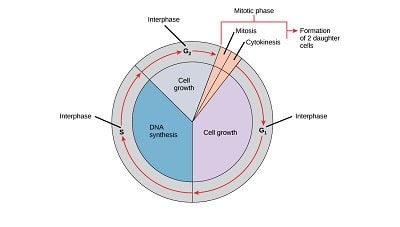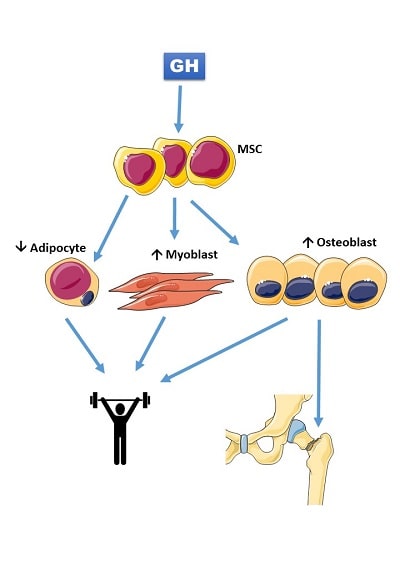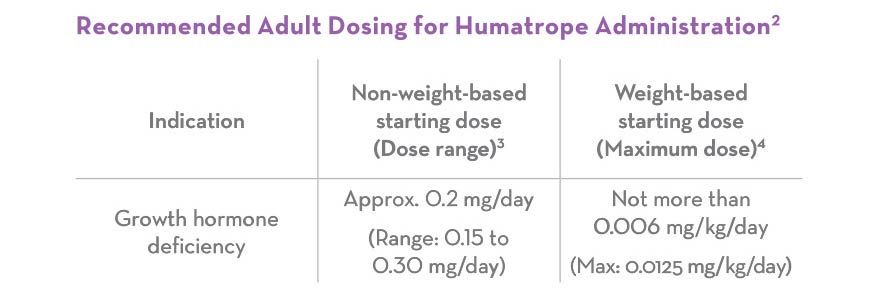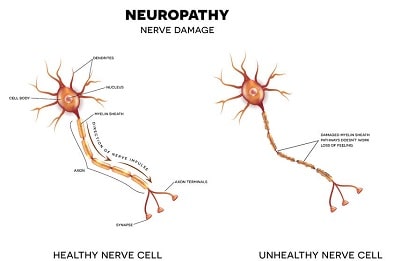Whether you are an athlete recovering from a sports-related injury or a patient recovering from surgery, human growth hormone (HGH) and its partner hormone, insulin-like growth factor 1 (IGF-1), are critical components of any therapeutic recovery strategy. In fact, one of the primary roles of HGH in the human body is to facilitate nerve, cellular, and tissue repair. HGH has been shown to initiate the tissue repair process in a number of ways, including by activating stem cells that then form new, healthy tissue:
“GH is a prohormone that depending on the tissue may be proteolytically cleaved giving origin to different and shorter GH derivatives with tissue-specific properties…. [then] activate the proliferation of tissue-specific stem cells that they would act in tissue repair after an injury.”
Let’s get into the specifics in terms of the benefits that HGH delivers for a variety of repair processes including cell regeneration, muscle recovery, bone repair, ligament and tendon repair, and nerve regeneration.
Growth Hormone and Cell Regeneration
 Throughout our lives, our cells in various tissues and organs undergo a regular process of creation, upkeep, reproduction, and death. The cell cycle, also called the cell life cycle, is divided into four phases:
Throughout our lives, our cells in various tissues and organs undergo a regular process of creation, upkeep, reproduction, and death. The cell cycle, also called the cell life cycle, is divided into four phases:
- Cell growth
- Cell copies DNA
- Cell DNA separates into two sets
- Cell self-divides cytoplasm, creating two new cells
A healthy, normal cell cycle means that tissues stay young and function – making it a critical ongoing process for anti-aging. Whenever a tissue or organ is damaged, the cell regeneration process begins to work to replace damaged cells with fresh, fully functional ones. HGH, a pro-growth (or “anabolic”) hormone, plays a critical role in mediating the cell division process:
“The release of growth-promoting hormones, such as HGH, can initiate cell division, and a lack of these hormones can inhibit cell division.”
Accordingly, human growth hormone replacement therapy (HRT) has been implicated in numerous cell regeneration processes – for example, in:
- Speeding liver cell regeneration following hepatic injury
- Regenerating hair cells damaged from acoustic (sound) trauma.
- Regenerating brain cells following brain injury
That’s why, as we will explore here, even mainline medical groups like the University of Illinois – which are traditionally skeptical of hormone-based therapies – have begun to come around to the near-miraculous healing potential of HGH for cell regeneration:
“Treatment with growth hormone could be used to speed repair after injuries or surgery in the elderly, shortening recovery time.”
Can HGH Be Used for Muscle Recovery?
One of the main benefits of HGH popular with athletes and anti-aing enthusiasts is its remarkable capacity to speed muscle recovery after exercise. In one landmark study of HGH administered therapeutically to a group of healthy men over 50, researchers arrived at the following conclusion:
“We observed a statistically significant increase in leg press responsive muscles (quadriceps being the mainly muscle evaluated) when compared to placebo…”
Beyond a mere increase in strength, the researchers noted, HGH supplementation reinforces the tissue matrix within the muscles, significantly reducing the risk of injury during physical activity:
“GH use could attenuate or prevent muscle fiber injuries, causing a lower frequency of training disruption and leading to greater training in athletes or nonathletes with the use of GH, which leads to a muscle fibre hypertrophy and consequently an increase in strength.”
In addition to spurring muscle growth (hypertrophy), HGH delivers the added benefit of speeding muscle recovery and repair in combination with IGF-1:
“GH had positive effects on somatic and skeletal muscle growth early in the recovery process, possibly via endocrine IGF-I-stimulated protein accretion. In contrast, the enriched diet promoted fat deposition with no impact on skeletal muscle growth recovery.”
The bottom line: HGH supplementation, regardless of age but especially in older adults, helps to prevent exercise-related injuries, speed muscle recovery, and ultimately, increase strength – a vital benefit for patients aiming to achieve the anti-aging effects of sustained musculature late into life.
Can HGH Be Used For Bone Repair?
 HGH is essential for recovery from bone fractures. Following an injury involving a broken bone, mesenchymal stem cells go to work initiating the various processes involved in tissue repair, including angiogenesis (new blood cell formation) and cellular regeneration:
HGH is essential for recovery from bone fractures. Following an injury involving a broken bone, mesenchymal stem cells go to work initiating the various processes involved in tissue repair, including angiogenesis (new blood cell formation) and cellular regeneration:
“Mesenchymal stem cells actively respond to stress or injury…When supplied exogenously, MSCs… can promote angiogenesis, regeneration, remodeling, immune cell activation or suppression, and cellular recruitment.”
HGH facilitates the transformation of MSCs into new, healthy bone tissue:
“GH promotes osteogenic differentiation of MSCs, and this effect is enhanced in combination with other growth factors. Overall, these findings indicate that MSC, independently from tissue origin, are a target for GH activity that, by modulating their commitment, could influence body composition.”
Supplemental growth hormone introduced through therapy “exerts direct anabolic effects on human osteoblasts,” keeping bones strong and healthy and facilitating their repair following injury. The bottom line: what this means, in addition to protecting against age-related bone loss (osteoporosis), is that HGH speeds new bone formation following an injury in which a break occurs.
Does HGH Help Repair Ligaments and Tendons?
Both tendons (the connections between muscle and bone) and ligaments (the connections between bones) are primarily made of collagen:
“Ligament, tendon, and fascia are soft tissues composed primarily of collagen fibers. In ligaments and tendons these fibers are organized into roughly parallel bundles to transmit tensile forces between two bones (ligament) or between muscle and bone (tendon).”
 Given their function, damaged ligaments and tendons can create extreme mobility issues as well as chronic pain in patients with injuries to these connective structures.
Given their function, damaged ligaments and tendons can create extreme mobility issues as well as chronic pain in patients with injuries to these connective structures.
The clinical evidence indicates that HGH substantially increases collagen production in HGH-deficient patients, particularly through increased levels of type III procollagen propeptide which is a critical precursor for collagen synthesis and, in turn, tendon and ligament repair:
“The effect of increasing doses of growth hormone on collagen synthesis in GH-treated GH-deficient patients was determined in a short-term study… Type I collagen is mainly found in bone and type III collagen in loose connective tissue. We observed a GH dose dependency of both procollagen propeptides. Serum type I procollagen propeptide was significantly higher following GH… Serum type III procollagen propeptide increased twice as much as type I procollagen propeptide, by 47 vs 25%.”
The bottom line: HGH facilitates tendon and ligament repair through a variety of mechanisms, including boosting production of collagen, the building block of tendons and ligaments.
What Is the Ideal HGH Dosage For Injury Recovery?
The standard HGH dosage for injury recovery ranges from 0.15 to 0.3 mg of the hormone per day, with the exact recommended dose depending on a number of factors:
- Age.
- Sex.
- Weight.
- Medical history (chronic diseases, allergies, etc.).
An example of typical dosages of Humatrope, a popular HGH supplement produced by Eli Lily.

On average, a 0.2 mg/day dose is enough to speed recovery following injury, illness, or surgery. Your hormone specialist (endocrinologist) can help determine the suitable dosage for you based on the individualized criteria discussed above as well as your healthcare goals.
Can Growth Hormone Help with Arthritis?
Optimal growth hormone levels are tied to healthy inflammatory responses (the primary driver of arthritis in most patients). Conversely, abnormal HGH/IGF-1 levels contribute to the development of arthritis:
“Abnormalities in GH/IGF-I were observed in patients with different forms of arthritis. When concerning body composition (BC), both severe and partial GHD are characterized by increased fat mass, especially truncal, and reduced lean mass.”
When the patients received therapeutic HGH replacement therapy, the abnormalities reversed:
“Long-term GH replacement at physiological doses improved the abnormalities… their normalization (by GH replacement or treatment of acromegaly) reverses most of these abnormalities, thus confirming their GH-related etiology.”
In particular, HGH is suitable for treating targeted forms of osteoarthritis (OA), such as those affecting the temporomandibular joint (TMJ):
“Intra-articular injection of GH improved OA scores in rat TMJs in both cartilage and subchondral bone of the condyles without affecting condylar bone growth.”
The bottom line: The inflammatory disease process that causes arthritis is linked to abnormal HGH levels. Accordingly, correcting HGH levels through therapy reduces the risk of arthritis.
How Can HGH Be Helpful For Surgery?
HGH is absolutely beneficial for therapeutic use both before and after surgery for many patients. Here, we’ve broken down the benefits of HGH into pre-surgery preparation and post-surgery recovery.
HGH Before Surgery
Because of its invasive nature, surgery can have detrimental long-term effects on the body, including by stunting the musculature (often called “surgery-induced acute muscle wasting”, especially among older patients:
“Age ≥65 years and diabetes were independently associated with clinically relevant muscle wasting within 1 week after gastric cancer surgery. Clinically relevant muscle wasting was associated with a poorer [quality of life] QOL and short-term outcomes after surgery.”
Accordingly, HGH, which protects muscle tissue, represents an invaluable pre-surgical treatment strategy to increase the odds of a complete and speedy recovery coming out of successful surgery:
“The latest research shows that the use of anabolic steroids and HGH (human growth hormone) during the pre and post-surgery phase, provides a significant improvement in recovery after several orthopedic surgical procedures.”
HGH For Post-Surgery Recovery
In addition to pre-surgical use, the therapeutic administration of HGH following surgery, based on the clinical evidence, should be a standard part of post-operative care for many patients. In one study published in Hormone Research, the researchers concluded that HGH supplementation exerts the following beneficial effects for patients coming out of surgery:
- “overcomes the protein catabolic effects of the trauma response induced by major or moderate surgery by increasing protein synthesis”
- “improves humoral and cellular systemic host defenses, thus reducing the risk of infection”
- “preserves or increases lean body mass and reduces adipose tissue
- “minimizes POF” (postoperative fatigue syndrome)
In fact, in one study on patients undergoing ACL knee surgery, researchers reported an impressive “29% higher knee extension strength in our patients that had performed the HGH injections compared to those in the placebo group.” The bottom line: HGH, used both pre-and post-surgery, significantly increases the chances of a full recovery following the procedure.
HGH and Nerve Regeneration
 Traumatic injuries, as well as many chronic illnesses, can impact nerve function. Nerve damage might be caused by a number of conditions:
Traumatic injuries, as well as many chronic illnesses, can impact nerve function. Nerve damage might be caused by a number of conditions:
- Chemical poisoning
- Neurodegenerative illness (Alzheimer’s disease, Parkinson’s disease, etc.)
- Diabetes and other metabolic disorders
- Drug use (both prescription and illicit)
- Traumatic injuries
Regardless of the cause, engaging with therapies that can repair nerve cells is critical to recovering quality of life following nerve damage:
“GH is involved in neurogenesis, myelination, and synaptogenesis… in adult brain functions, including learning and memory, locomotion, psychological behaviors, and neuroprotection. GH receptors and IGF-1 receptors are expressed in various brain regions, such as the cerebral cortex, hippocampus, and choroid plexus.”
In multiple studies, human growth hormone has proven to be extremely effective for nerve regeneration following a denervation injury:
“GH-treated animals demonstrated enhanced median nerve regeneration… These findings support the hypothesis that GH-therapy enhances axonal regeneration and maintains chronically-denervated muscle to thereby promote motor re-innervation and functional recovery.”
Specifically, the improved outcomes for HGH-mediated nerve repair include:
- Greater axon density
- Greater axon diameter
- Greater myelin thickness (the protective sheath covering nerves)
- Improved muscle re-innervation
- Reduced muscle atrophy
- Greater recovery of motor function
The bottom line: HGH supplementation following nerve damage produces stronger, healthier, more resilient nerve cells that perform better for optimal cognitive health, stronger and bigger muscles, and restored motor function.

